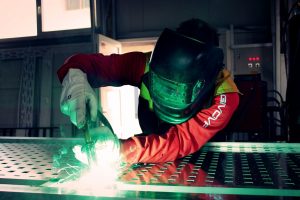Print a Sign-In Sheet | Spanish Version Coming Soon
There are several different types of welding. A basic definition of the welding process involves the fusion of two metals by heat or pressure. When welding, safety hazards are present. Below is information about the various types of welding processes and tips to stay safe.
Welding Basics:
- Over 80 variations
- Uses electrode wiring
- Electrode holder “stinger” – holds the electrode wire
- Welding gun
- Flux – cleaning/protecting agent and protects the weld from contaminates.
- Uses compressed gas
Types of Welding:
- Arc Welding
- Most common type
- Examples — Stick, MIG, GMAW, FCAW, SAW, TIG, Plasma
- Heat is supplied by various means (electric, plasma, laser, etc.) The base metal is then melted; while a filler metal may be added, bonding two metals together.
- Involves the most processes
- Oxy-acetylene Welding (OAW)
- Also used to cut through metal
- Combo of oxygen and acetylene gas
- Resistance Welding
- Spot, seam, projection, resistance butt, flash butt, percussion, high frequency
- Solid-State Welding
- Uses both heat and pressure
- Cold, diffusion, explosive, forge, friction, fabrication, hot pressure, roll, ultrasonic
- Thermo-Chemical Welding
- Thermit, atomic hydrogen
- Uses often in the railroad industry
- Radiant Welding
- Electron beam, laser beam
- Found often in nuclear facilities
- Very expensive
Hazards of Welding:
- Burns oxygen
- Air contaminants
- Fumes
- Gases
- Smoke
- Hazard Control
- Use local exhaust ventilation
- Powered Air-purifying respirators (PAPR)
- Physical agents
- Shock
- Fire/explosions
- Radiation
- Hot materials
- Hazard control
- Remove/replace any damaged or cut electrical cords/wiring.
- Do not use electrical tape as a repair.
- Do not leave the electrode in the holder when storing. Once turned back on the electrode is energized and can shock the operator.
- No homemade welders.
- Remove damaged equipment, mark it, or tag it.
- Welders should be placed in the proper holder when not in use, not lying on the ground or a table, etc.
- Danger signs should be posted in the area.
- Sparks flying near compressed gas cylinders.
- Oil or grease cannot be stored next to cylinders.
- Do not store different types of gases together.
- Cylinders must be capped and regulators off when stored.
- Fire Watch required if appreciable combustibles are within 35 feet radius of the welding operation.
- Welding screen in place to protect passersby.
- Ensure proper fall protection if working from heights.
- Hazard control
- Hazard Control
Hazard Control – Hierarchy of Controls
- Engineer it out
- Remove hazardous conditions
- Place a barrier between the worker and the hazard
- Install local exhaust ventilation
- Administrative controls
- Worker rotation
- Product substitution
- Safer work practices
- PPE
- Respiratory protection
- Eye & face
- Hands/arms/body
- Helmets/shields
- Suits
- Hearing protection
- Gloves
- Respirators
Prohibited Areas
- No welding in areas not authorized by management
- No welding in areas with sprinklers that are not properly working
- No welding in areas with explosive atmospheres (i.e. Tanks)
- No welding in areas with bulk storage of ignitable materials
Management Responsibilities
- Safe use of equipment
- Training on the proper use of equipment
- Establish a designated welding area
- Designate person for authorizing welding outside of the designated area (hot work permit).
- Advise contractors conducting the welding of site-specific hazards.
- Determine that the welders secure approval before starting work.
KEMI does not assume liability for the content of information contained herein. Safety and health remain your responsibility. This information is to be used for informational purposes only and not intended to be exhaustive or a substitute for proper training, supervision or manufacturers’ instructions/recommendations. KEMI, by publication of this information, does not assume liability for damage or injury arising from reliance upon it. Compliance with this information is not a guarantee or warranty that you will be in conformity with any laws or regulations nor does it ensure the absolute safety of any person, place or object, including, but not limited to, you, your occupation, employees, customers or place of business.

